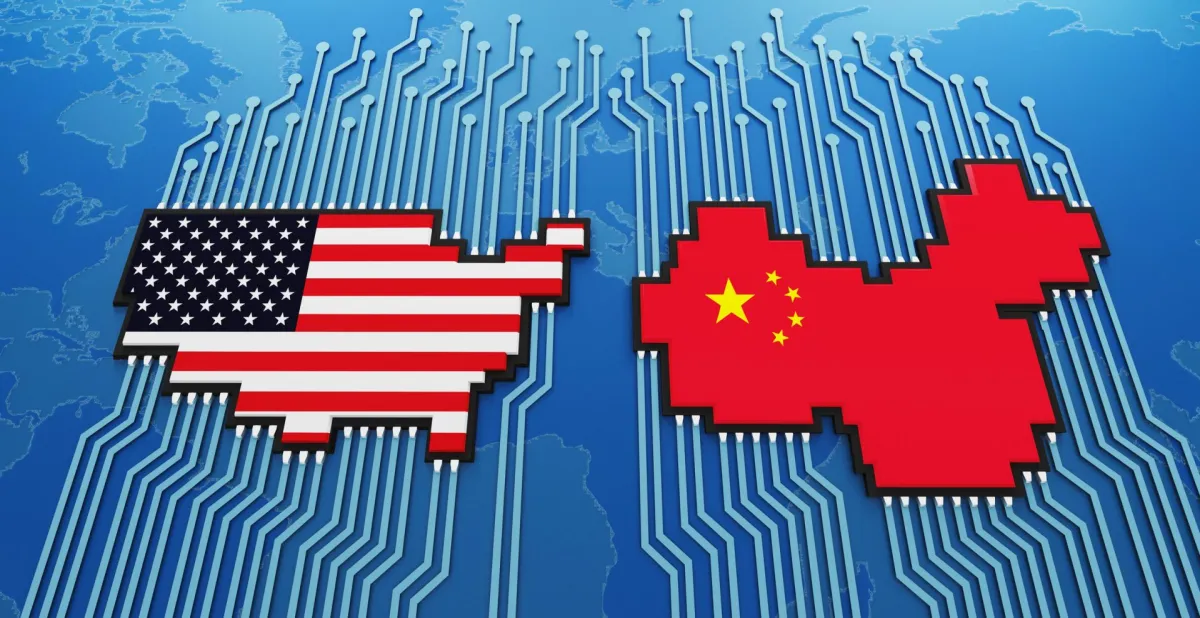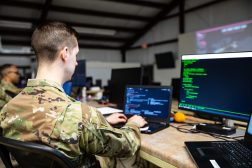Experts link up in Thailand for US-China Track 2 dialogue on AI

Headlines swirled after high-level envoys from the U.S. and Chinese governments met in Geneva last week for their first-ever official bilateral dialogue on artificial intelligence, following an agreement Presidents Joe Biden and Xi Jinping made in November.
At the same time, over in Thailand, a lesser-known, well-planned, and deeper-diving exchange on AI also unfolded between professionals from America and China, outside of official channels.
It marks the latest part of an ongoing series of unofficial dialogues between influential experts from those countries with close government ties, who want to help improve communication between the two nations, particularly in preparation for an uncertain technological future.
“The whole point of a Track 2 dialogue is to have open and candid discussions between countries that might not be able to have those same discussions at the official government level,” Lt. Gen. Jack Shanahan, a retired Air Force pilot and first director of the Defense Department’s Joint AI Center (which later merged with other organizations to form the Chief Digital and AI Office), told DefenseScoop in an interview before he left for that engagement.
While Track 1 dialogues are formal meetups by professional diplomats and other government insiders, Track 2 engagements are led by non-governmental experts and practitioners.
In separate conversations earlier this month leading up to the event in Thailand, Shanahan and a former senior U.S. official also deeply involved (who spoke to DefenseScoop on the condition of anonymity) provided new details about their expectations for this latest closed-door Track 2 meeting. They asked DefenseScoop to hold publication until after the dialogue concluded, citing aims to “protect the process,” but agreed to share more information once they leave Asia.
“I’m not doing this just because it makes me feel good. I’ve got plenty on my plate to do without having to do this. But I believe that — given the gravity of what we’re talking about when we talk about lethal autonomous weapon systems, when we talk about AI and nuclear command and control — why would we not want these unofficial dialogues to help inform what we hope will be more and more official talks? Because AI is just too important right now, and there’s just too much going on worldwide,” Shanahan said.
From principles to practice
U.S. military leaders and lawmakers have been increasingly candid in their assessments of the People’s Liberation Army as a top security threat. They’ve also issued stark warnings that the Chinese government has been targeting America’s defense and critical infrastructure in an intensifying manner over recent years.
Against a tense backdrop, both nations are also simultaneously vying to be the world’s top AI power in the next decade, and they’re each considered among the leading global developers and deployers of this crucial emerging technology. After meeting in late 2023, Biden and Xi revealed near-term plans for the two countries’ governments to engage in formal talks on risk and security issues associated with AI.
The Track 1 dialogue in Geneva last week marked the first product of that agreement.
“I think you can say with some degree of confidence that artificial intelligence probably wouldn’t have been one of the seven things that the leaders had as deliverables from their summit in San Francisco in November last year, had it not been for Track 2 dialogues — because it’s so complicated that you need to kind of set the table and, frankly, get officials on both sides comfortable with having this be something that they could push up to their leaders and recommend that their leaders talk about,” a participant in the Track 2 meeting in Thailand told DefenseScoop on condition of anonymity.
“Good Track 2 dialogues have some connection to Track 1s — [often] through former officials like myself and [Shanahan], who can just go talk to our old colleagues and basically debrief over a beer. You can tell people that you know what you’re working on, and you hope the same thing happens on the Chinese side,” they said.
Both officials got involved with these Track 2 dialogues post-government retirement, in 2018 and later. It was around that year when one forward-thinking expert brought AI to the table as a potential topic for the series.
“I think part of the moment was [it was] a time where AI was expanding,” the former senior U.S. official noted.
Under the Communist Party, “the Chinese way of addressing almost anything is to figure out some big picture principles,” they said — “but we quickly took them, what I call, ‘from principles to practice.’”
They used a variety of simulated scenarios and case studies covering emerging and potentially disruptive AI issues, to demonstrate that simply setting overarching principles would not help their militaries in real-world situations.
“You can imagine all kinds of scenarios. One involves kind of a tabletop roleplay where a weapon hits a plane and kills the pilot from the other country — we didn’t call it the U.S. and China, we would call one Green-Land and one Blue-Land, it could be anything — but the exercise was partly to prove that, actually, that wasn’t our intent [and] it was the algorithm that did something wrong,” the official explained.
Very quickly, those involved recognized that in “a highly charged environment like the U.S. and China,” as the official put it, “nobody’s going to believe either side if they said” that they accidentally killed a member of the other nation’s military.
Typically, it would be assumed that the incident was intentional — and unless personnel do immense work on safety standards and technology transparency in the systems’ preparation, they can’t prove that they accidentally took down an asset or killed a member of the other party.
“I think that was a big eye-opener for the Chinese, because they realized that they couldn’t just talk about principles, and that they were going to have to get into more detail,” the official told DefenseScoop.
“Even today, that’s our comparative advantage. That’s what we bring to this discussion, maybe better than any other bilateral or multilateral dialogue. Maybe they had one idea in mind, which was to talk about big picture principles — and I think we’ve been successful in convincing them that it’s in their interest to actually talk about the nitty-gritty with American and international experts. Because, at the end of the day, nobody wants a weapon system to do something it wasn’t intended to do. That’s our biggest kind of contribution in this space,” they added.
However, while the impacts have seemed palpable, the engagements aren’t always totally seamless and comfortable.
“We had one time where we were talking about acceptable error rates. And I remember, maybe he was joking, but a Chinese official said something like, “Oh, we need a 75% safety level.’ And we’re like, ‘25% risk of an accident is okay for you?’ The Americans couldn’t believe it. Then he said, ‘Yeah, what’s the cost of that? One dead American?’ [Maybe] he was joking, but that was pretty contentious,” the senior official said.
Eyes wide open
The experts involved in these Track 2 dialogues have been perfecting their processes over the last half decade and tackling new AI themes over time.
When Shanahan got involved around 2020, right after retiring from DOD, the Chinese and American Track 2 participants were developing mutual definitions and a voluntary code of conduct for the use of autonomous weapons by their militaries.
“It took us a while to understand, with the Chinese, that they look at lethal autonomous weapons systems — in their definition — just differently than we [from the U.S.] did. And we were talking past each other,” Shanahan explained.
It wasn’t until they “both really put things down in print,” he said, that they were able to really grasp the differences in their societies’ understanding and perception of AI.
“You can translate any word in any language — but it’s more than translation. It’s actually an interpretation, it’s how it’s used. We might say ‘system,’ but the Chinese might say ‘platform,’ or at least it translates to platform. So, you have to work your way through this,” Shanahan noted.
From this theme of definitions, the experts moved on to the concept of AI test and evaluation. Generally, people with technological expertise have a pretty clear notion of hardware and software T&E practices over the last several decades.
“But this goes even further than that. AI test and evaluation is different enough that you want to talk about it. And we want to explain why it’s in our best interest as a community — as an international community — we’ve got to get this right,” Shanahan told DefenseScoop.
The other former senior official involved, who spoke on the condition of anonymity, pointed out that China and the U.S. would likely not let the other’s government lead an investigation into their military in the case of a weapons accident.
“China’s probably not going to let the National Transportation Safety Board come in and take a look at an accident that happens for them. We’re trying to develop some standards about what would be the post-incident investigation. Maybe an incident is a fatality, maybe it’s lost to a major asset — it can be as small as a tank or could be as large as a ship. But how do you trust that if something goes wrong, that’s going to be investigated and ultimately, the cause is going to be found, and that other country is not going to put that asset back into the field until it’s been remediated?” the official said.
That’s one “piece of our test-and-evaluation guidelines that I really think could be practical and could help make weapons safer,” they added.
In Thailand, those involved on the U.S. side intended move to finalize the proposed standards. Ahead of the dialogues, the team met with Pentagon officials from policy and emerging technology offices regarding their plans — and after, they’re slated to meet to discuss the outcomes.
Beyond those efforts in Thailand this year, they’re also planning to launch pursuits around a new theme: the intersection of generative AI and chemical and biological warfare, or “chem-bio.”
Generative AI and associated large language models (LLMs) can be prompted by humans to produce (convincing but sometimes inaccurate) software code, images and other media. Such systems continue to get more and more “intelligent” each time they’re trained with more data — but with so much uncertainty around how they function or might evolve, they pose both unrealized opportunities and risks for militaries.
“If you think about things that [Shanahan has] done in the past, like the attempt at Project Maven was looking at images and thinking about how AI can gather information from images and assist perhaps in targeting, or other areas. But now, with the development of AI in the chem-bio space, AI can now also analyze proteins and it can analyze chemical compounds, and it can come up with new and different ways of creating things. Some can be life-saving drugs, but for a terrorist, it could also be your next biological weapon or chemical weapon that could be created with AI,” the former senior official noted.
Because that tech already exists and is evolving, guardrails should be proactively thought out, in their view.
“The technology is, in some ways, what drove people to pursue this [theme, next]. This idea that there’s something called a biological design tool, and when used alongside an LLM — a large language model like ChatGPT or Ernie Bot, they name their things after Sesame Street characters in China, I guess to make them seem less dangerous — but these kinds of things, they can do this now,” the official said.
“So, Thailand is a stepping stone towards developing standards, like we’ve done in testing and evaluation in the past, and like we hope to do on CBW and terrorist threats in the future,” they added. “But will that come just from Thailand? Probably not.”
In the separate interviews, both that expert and Shanahan acknowledged a variety of critiques they’ve received for participating in Track 2 talks.
“I’m sure every meeting we have somebody whose job it is to collect information on us, as well. That’s okay. We actually want to impart information. And it’s faster if they write a report and send it directly through their intelligence,” the official said.
Shanahan said he “understands completely” that many people have a more pessimistic view of these types of unofficial, behind-the-scenes engagements.
“I can be cynical at times, as well. But I just believe that we ought to try, and I walk into every meeting with my eyes wide open,” he told DefenseScoop.
“I know it gets, I think, falsely attributed to [Winston] Churchill, but whoever it was that said ‘To jaw-jaw is always better than to war-war’ — it’s the same thing, just said a little bit differently. So, what comes out of it remains to be seen, but I would say I’m actually pleased that we’ve gotten as far as we’ve gotten, so far,” Shanahan said.






